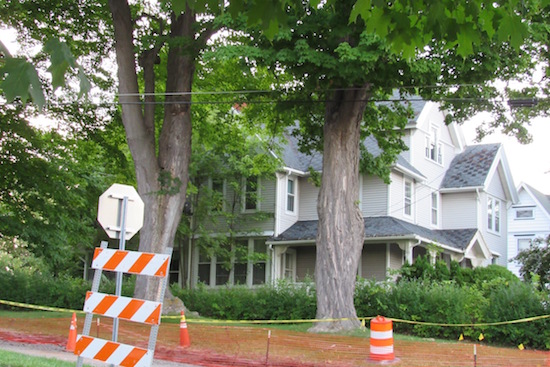Instead of 50-50 split, EPA now eyes 90 percent of sale proceeds in Holley

Photo by Kristina Gabalski: One of the homes affected by a leak from Diaz Chemical sits on the northwest corner of the South Main Street/Jackson Street intersection. During Monday’s meeting of the Village of Holley Development Corporation, President Dan Schiavone said the home is appraised at $62,500 with lead clean-up is expected to cost $3,400.
HOLLEY – Members of the Village of Holley Development Corporation have given approval for VHDC President Dan Schiavone to sign an agreement with the Environmental Protection Agency which would transfer ownership of the eight “Diaz homes” in the village from the EPA to the VHDC.
VHDC members met Monday evening at the Village Hall to discuss two significant changes in the agreement. The two parties have been at an impasse for nearly a year over terms regarding lead abatement.
“After months and months of not hearing (from the EPA),” Schiavone said the EPA now has told him they have been looking into situation and the latest agreement offered includes a 90 percent/10 percent split on the sale of the homes. That means 90 percent of the sale price goes to the EPA and only 10 percent goes to the VHDC.
Initially, the VHDC had hoped to receive much more on the home sales. A previous agreement had included a 50/50 split with the EPA.
“The 90/10 percent split is awful,” Schiavone said. “The LDC isn’t going to make any money for future projects.” He noted that fees and closing costs are not subject to the split.
“We thought we would have a nice chunk of change,” he said. “We will be lucky to get ($5,000-$7,000). That will not take us very far.”
He said the EPA explained that the 90/10 split is how the agency handles agreements between the federal and state governments. In the case of the Diaz homes, the VHDC is “acting on behalf of the state,” Schiavone said.
“The best we can get on the sales is 10 percent.”
The federal agency has been caretaker of the former Diaz site since the company declared bankruptcy in June 2003, following a chemical leak in the community on January 2002.
“We will grumble, but we will sign the MOA,” Schiavone said about the agreement. He recounted efforts the committee has made to come to a more favorable agreement including contacting Sen. Charles Schumer who assisted in their efforts.
Schiavone said the EPA is “anxious to get out of paying for the properties. They have been pinned down for code violations and have had about enough.”
But he said he feels the VHDC will not be able to make further progress with negotiations. The local LDC was formed to get the properties sold and back on the tax rolls.
“We need to get the project moving forward again,” Schiavone said.
On the lead abatement issue, the agreement requires lead clean-up completed by a certified contractor. Those who purchase the homes would be responsible for having the clean-up work completed. Documentation of certified clean-up must then be provided to the village code enforcement officer before a certificate of occupancy is issued.
Schiavone said the EPA will disclose its reports on contamination levels in the homes as well as the estimated cost of lead clean-up to prospective buyers. Schiavone said the EPA told him that once the agreement is signed, ownership of the properties would be ready for transfer in six weeks.
“In federal government talk that means three months,” Schiavone mused. The VHDC will also assume responsibility for maintenance of the properties as soon as the agreement is signed by all three parties involved – the VHDC, the Village of Holley and the EPA.
Those in attendance at Monday’s meeting, including Holley Mayor Brian Sorochty, discussed the possibility that the village could provide mowing for the properties. The agreement further stipulates that the EPA must approve of the final sale price of the homes.
VHDC member Krista Wiley expressed concern over the stipulation and requested Schiavone inquire if a time deadline could be placed on the EPA to respond to a written notice of a final sale price. She said she also worries that the VHDC might get stuck with the properties if the EPA “doesn’t agree with the price.”
“I think there is potential in all the properties,” Schiavone said. He agreed to discuss the possibility of setting a time limit for the EPA to respond the the sale price. Schiavone said the committee would meet again once the quit claim deeds are on the way.
“Then we will have to decide how to sell the homes,” he said. The committee has a real estate attorney to provide guidance and has discussed auction, RFPs, listing with a real estate agent, or a mix of methods as possibilities.






































































